Centenary Radio: KFI: Earle C. Anthony’s Vehicle At 100
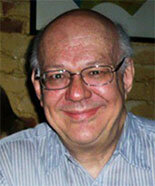
[April 2022] Radio is quite different from the way it started in 1922. In Los Angeles, when KFI signed on 100 years ago, the half dozen or so stations all shared one frequency. Today, KFI is still there, standing among the top rated stations among over 100 stations broadcasting in the air over LA.
On the air, Lohman and Barkley, the KFI Morning Drive stars in the 1970s, used to say “This is KFI, the Worlds’ Largest Radio Station.”
While in many ways that statement was more than a bit of hyperbole, KFI was indeed, for many years, the most powerful radio station in the US, especially when you consider their 50 kW and the 640 kHz dial position. At the lowest frequency for what was then a US Clear Channel station, KFI’s reach was tremendous: from the western half of the Continental US all the way out to the Pacific Ocean, well past Hawaii.
Which is just the way Earle C. Anthony liked it.
ON THE CUTTING EDGE
Earle C. Anthony had been a keen technologist and entrepreneur even as a youth. At 17, he built a working electric car.

Then he made a motion picture camera.
With his father, he developed a car dealership and invented the “filling station,” opening the first two in California. His symbol was the Chevron, which he sold to Standard Oil a few years later. He even influenced the building of the Golden Gate Bridge and started what would be the Greyhound Corp.
However, the reason we are talking about Earle C. Anthony today is yet another innovation that he grabbed hold onto: radio. An article in The Saturday Evening Post sparked his interest in a potential way for him to communicate between his dealerships, as well as it being an interesting hobby.
It did not take long for Anthony to build a transmitter – literally on a breadboard on his kitchen table – receive a license from the Department of Commerce, and begin broadcasting on April 16, 1922.
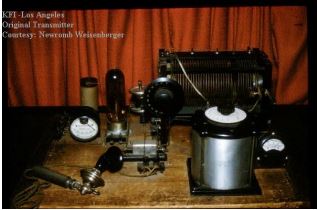
Earl C. Anthony’s first transmitter was
a true “breadboard” construction.
True to his entrepreneurial background, Anthony immediately had seen the value of the radio station as much more than for internal communication: it could be of great value in bringing in new customers to his car business.

The transmitter was placed on the roof of his dealership at 1000 Hope Street in Los Angeles, and he quickly arranged with the LA Herald and Examiner newspapers for news reporting and regular programs began to go out every day.
TIRELESS PROMOTION
But, lest you – or anyone – wonder for a moment who was responsible for it all, the station ID at the top of the hour would make it very clear: “This is KFI, the Radio Central Superstation of Earle C. Anthony, Incorporated, California Packard Distributors.”
Another early method of advertising the station was mounting signs emblazoned with “KFI – PACKARD” on the KFI towers up on the roof of the auto dealership. Even the dashboard plaques placed in his cars mentioned KFI.
Through the years, Anthony worked hard to promote KFI and KECA (which he bought in 1929, only to be forced by the FCC to sell in 1944).
Once he offered to give a crate of California oranges to every listener writing in. However even Anthony had failed to comprehend exactly how popular this new medium was with the listeners. He got so many postcards requesting the gifts that he was forced to find the smallest possible oranges so he could ship three of them in a miniature “crate” to each listener.

A distinctive QSL stamp was also produced to send to the listeners, incorporating the KFI towers, orange groves, the mountains, and of course, a Packard radiator.
MORE POWER
Of course, the original 50 Watts was not sufficient for all this activity.
Anthony was not slow about growing KFI. Later in 1922, he started the climb to higher power: 100 Watts, then 500 Watts. In 1924, he jumped KFI to 1.5, 3, 4, and finally 5 kilowatts. Reception was reported in Sheffield, England.
But the big jump had to wait a few years until a large enough transmitter was available and the transmitter site and tower constructed. In 1931 KFI became the first in the West to run a full 50,000 Watts from their new site in Buena Park/LA Mirada, southeast of Los Angeles.
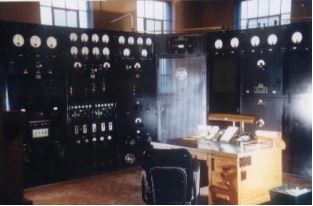
The RCA 50B transmitter was upgraded
and kept the station on the air until 1959.
It took a lot of power to run the station, and KFI required – and got – its own substation.
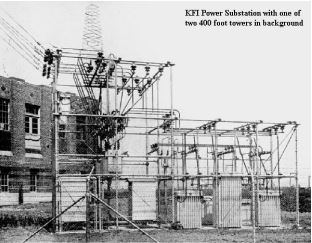
The KFI power substation in 1931
With all that power, KFI was rightly billed as the “country’s most powerful station” (based on the combination 50 kW at 640 kHz).
KFI certainly proved to have a long “reach.” Heard throughout the West, KFI was at least as important a station as any of the Clears in the East and Midwest.
Over the years, NBC itself tried several times to purchase KFI, but Anthony was steadfast in refusing any offers. He told NBC “I wouldn’t sell my wife. Why would I sell KFI?”
The transmitter site showed the love and care Anthony had for his station. A two-story building had the transmitter upstairs, and power transformers and generators downstairs. Built, as many were in those days, out in the country, it was a distinctive place, a cathedral to radio.
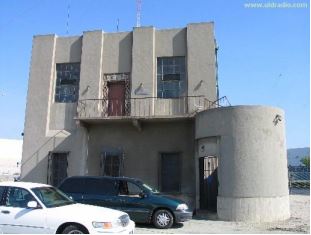
The KFI transmitter building
The transmitter site is still located in Buena Park/La Mirada, CA

Interesting for many, visitors, some building history is still visible on the tiles around the doorway, including the “radio waves” in the tiles.
STUDIO UPGRADES
December 1939 saw KFI and its sister station KECA (Earle C. Anthony!) move into new digs on Vermont Avenue.
Put simply, the station was a showpiece. And mindful of its beginnings, Anthony mounted the original 50 Watt transmitter in a showcase, and set it right in the lobby.
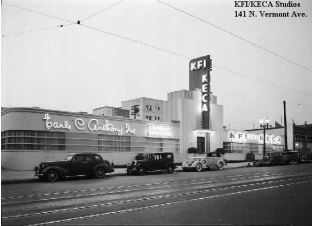
Along with the regular studios of varying sizes, a large auditorium was built for studio audiences to observe the various local and network programs that originated at KFI.
OWNER/PROGRAM DIRECTOR
Of course, being such a successful radio operator permitted Anthony to be properly eccentric.
Typical of the stories told in the KFI hallways was one about the time Anthony was in his personal train car, on the way to the Midwest. It was not uncommon for him to call in requests for his favorite records, but upon occasion he would also instruct the staff to “turn it up louder so I can hear it better out here.”
Another time late at night, tired of the standard “cowboy songs,” Anthony wrote “the ultimate cowboy song,” had a singer brought to his mansion where they recorded it, and then immediately had it taken down to the KFI studios to be put on the air. It may have been a true “hit” of the times: it was reported 20 people called in wanting to buy the new song!
Anthony kept his eye on KFI. He also pioneered in FM and TV operations, but these did not turn out to be as successful or profitable as the AM station and were sold off. In 1947, the KFI horizontal antenna was replaced by a 750-foot vertical tower. In 1959, the long-service RCA transmitter was replaced by a new Continental 317-B.
Even when the Packard dealership began to wane in the 1950s, Earle C. Anthony took great comfort in his KFI. “Every morning before I get up, I kiss a microphone,” he told his chief engineer.
HISTORY WALKING THE HALLS
When I was hired on as a studio engineer in the summer of 1970, it was immediately apparent that this was more than “just another radio station.”
A quick example: the KFI intercom system was a series of telegraph keys in the control rooms. For many years, a criterion of who was qualified to work at this powerhouse had been whether they understood and could tap out Morse Code messages as the program sources moved from studio to studio.
The whole station seemed to “reek” of history.
It was not merely the five studios, ranging from a tiny booth to that full performance studio, not just the large amount of custom equipment built by the station’s engineers over the years, not just a Master Control Room filled with racks of patch-bays and relays where everything in the station could be instantly replaced just by “patching around” it, from the microphones to pre-amps to key switches.
There just was “history” everywhere! You even saw it among the staff.
At that time, there were the 25 names on the engineering staff list. The eye-popper was the date of hire on the right side. The two co-chief engineers started in 1924, over 45 years before, just two years after Earle C. Anthony had put his first 50 Watt transmitter on the air. Several more had over 40 years of service.
During my stay at KFI, I got to work with some true veteran broadcasters, including Dave Garroway. But perhaps the most memorable two weeks of my stay at KFI (side from the day when I experienced my first LA earthquake!) was when I subbed for the long time engineer who worked the Lohman and Barkley show.
Although a top-rated program in the #2 Radio Market, those guys treated me in a completely professional way, and more. As my two weeks with them came to a close, they decided I was “an unsung hero of the Lohman and Barkley Show” – and proceeded to “sing me,” singing my name over and over again to the Hallelujah Chorus. Both embarrassing and exhilarating, it is one of my most cherished memories of radio at another time.
CHANGES
While I was there, it was truly a transition time for KFI.
As noted, Earle C. Anthony died in 1961. A trust was set up to run the stations, but the passion of Anthony started to wane. Maintenance and up-grade budgets were almost non-existent.
And, soon thereafter, the station was sold to Cox Broadcasting. Anthony’s co-chief engineers, Mason and Blatterman retired. The Vermont studios were sold off, with the station moving to an all new home in the Wilshire District of LA.
The on-air format was shaken up as well, and eventually morphed from Variety to Middle-of-the-Road to today’s News/Talk. Clear Channel bought KFI in 2000, and moved it to new studios in Burbank.
Of course, over the years, the transmitters have also been changed. A Continental 317-C1 from the late 1970s gave way to a Harris DX-50 and, later, a Nautel XR-60.
After over 57 years of service, the KFI tower was re-guyed in March 2004. It was quite a project, considering the tower height and the guy wires being over one inch in diameter, as well as the large number of buildings that had been constructed on the property.
The project was completed and the KFI tower was ready for many more years of service.
Then, silence.
TOWER DOWN!
Tragedy occurred on a quiet Sunday in December 2004. A private pilot out for a Sunday flight was not paying attention to the rules. While heading toward a local airstrip, he apparently descended far too low and smashed into the top of KFI’s tower.
Amazingly, the plane and tower dropped almost vertically, injuring no one in the business park that had grown up around the site. (It may well have been worse if the accident had occurred during the work week).
It took four years to finally replace the tower, including a terrible accident when a bolt gave way and the under-construction tower collapsed.
A story about that event and the reconstruction of the KFI tower is located here.
LOOKING BACK
I was not privileged to have been able to spend time with any of the gentlemen who actually built the station. As mentioned, Earle C. Anthony died in 1961.
But during the time I worked at KFI, I was able to wander the halls, spend time in each studio, and even if I do not have photographs to remind me, I still have strong memories of a station built for broadcasting. Later, when the movie “Lady Sings the Blues” came out, I was pleased to see they had used the old Studio A auditorium as a set.
Finally, after many years, I was reconnected with Newcomb Weisenberger, a long-time transmitter and studio engineeer at KFI. At that point long-retired in Long Beach, CA, Newcomb was kind enough to talk to me and share many of his memories of KFI – and writing a number of vignettes, which are posted on the oldradio.com site. You will find some very interesting reading here.
As it celebrates its 100th Anniversary, KFI is still a major Talk Radio voice in the second largest market in the US; as recently as five years ago it was listed among the Top 10 billing stations in the US.
Which is … just the way Earle C. Anthony would have liked it.
– – –
Are you interested in more Radio History?
Click here to sign up for the BDR Newsletter and get notice of when other articles are published.
– – –


